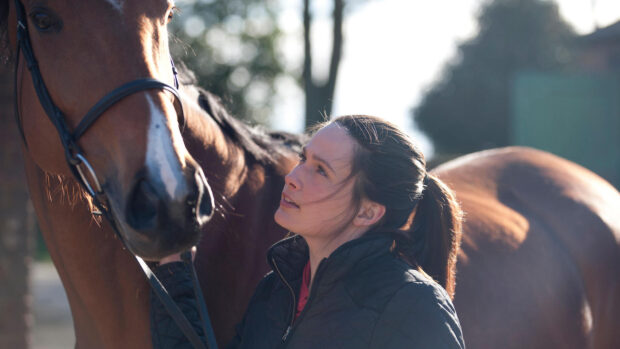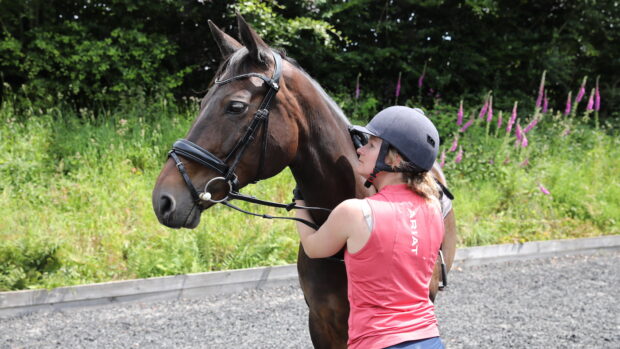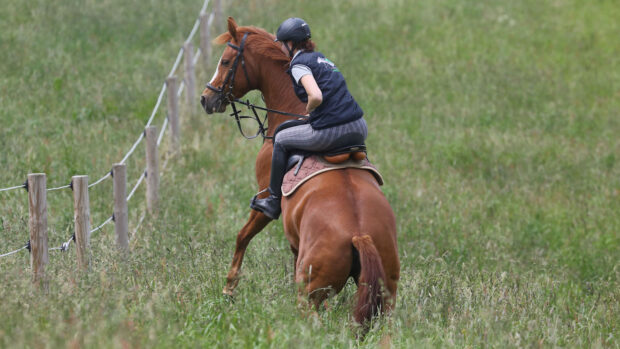Have you ever stopped and thought about how you reward your horse for good behaviour – and in what way that can influence how horses learn and behave in the future?
“Operant conditioning is how horses learn to operate within their environment and it’s really important to how we train horses,” says Dr Gemma Pearson, a qualified equine veterinary behaviourist who is director of equine behaviour for The Horse Trust.
The first aspect of operant conditioning is positive reinforcement.
“This is positive in the mathematical sense – the addition of something to reinforce behaviour, so that behaviour is repeated over time,” says Gemma. “This is the basis of clicker training, but you don’t have to use a clicker.
“What’s important is that you use an innatory reinforcer [something the horse naturally enjoys]. Horses don’t particularly enjoy being patted – they associate it with a break, perhaps, but it’s not something that matters to them – and they don’t enjoy being told that they’re good. We haven’t bred horses to want to please us in the same way as we have dogs.
“So for positive reinforcement we can use food, we can use scratches, we can use stroking the horse. And we can use that to train behaviours that we want, both in hand and under saddle.”
The other side of the coin in operant conditioning is negative reinforcement.
Gemma explains: “Negative doesn’t mean it’s a bad thing – you have to think about it in the mathematical sense. Maybe we should call it removal reinforcement instead,” says Gemma.
“This is the bread and butter of horse training. Negative or removal means subtraction of a cue when the horse offers the correct response. If you want to teach a young horse to go forward you might use a light leg cue and as soon as the horse goes to step forward, you release the pressure. Therefore the horse learns that stepping forward was the behaviour he needed to perform to make the pressure of the leg go away.
“This gives the horse control of their environment – we talk about them being able to operate in their environment because whenever they have any pressure put on them, they know what behaviour they have to perform to make the pressure go away again.
“We may use the legs to ask the horse to go forward, we may use the reins for slowing and stopping and we may also use the reins in a different fashion to get the horse to turn. If we give them a cue, as soon as the horse offers the correct response, we release that cue.”
Gemma stresses that “you get the behaviour you reinforce, not the behaviour you want” and that sometimes it’s easy to accidentally reinforce the wrong behaviour.
For example, think about a horse that’s difficult to worm. You put the wormer towards the horse’s lips and the horse throws its head up – that removes the pressure of the wormer from the horse’s lips, which accidentally reinforces that behaviour.
“Horses have no concept of winning and losing; they have no agenda, they don’t think they’re the boss or anything like that, but you get the behaviour you reinforce, not the one you want,” says Gemma.
The simple way to improve this is to put the wormer on the horse’s cheek and remove it before the horse moves its head away. Then over time, you gradually put the wormer closer to the horse’s lips.
Gemma explains: “Now the horse is starting to think, ‘Gosh this is different. Previously every time my owner put the wormer to my lips, I had to throw my head in the air to make the wormer go away, now I put my head down and relax and the wormer goes away.’ And because they keep their head still and relax, you can then easily insert the wormer into their mouth and they’re happier to have this done.
“We could accelerate this learning by using positive reinforcement, so we remove the syringe of the wormer but also give a click and give the horse a little bit of food for standing still and relaxed.”
The final aspect of operant conditioning is punishment, which can be positive or addition punishment where you add something, such as hitting the horse, or negative punishment where you remove something, such as taking away food.
“I think in this day and age, there isn’t really any need for punishment in horse training – we know that horses are not innately bad, we’ve often just accidentally reinforced the wrong behaviours or there’s another motivator involved, such as pain,” says Gemma. “Rather than trying to stop the behaviour we don’t want, which leads us down the route of punishment, we should think about trying to reinforce the behaviour that we do want instead.”
You can listen to Gemma talking about rewards, consequences and how horses learn on episode 126 of The Horse & Hound Podcast. She also recommends the British Equine Veterinary Association’s video on worry-free worming.
- To stay up to date with all the breaking news throughout London International and more, subscribe to the Horse & Hound website
You may also be interested in:

The Horse & Hound Podcast 126: showjumper Jessica Burke | Horse training: rewards | News

Fitness, polework and details: six training tips from double Olympic medallist Tom McEwen

Why the horse’s trot is the easiest pace to improve, plus other interesting facts

Rider biomechanics: 13 things to bear in mind if you want to be a good rider

Subscribe to Horse & Hound magazine today – and enjoy unlimited website access all year round




